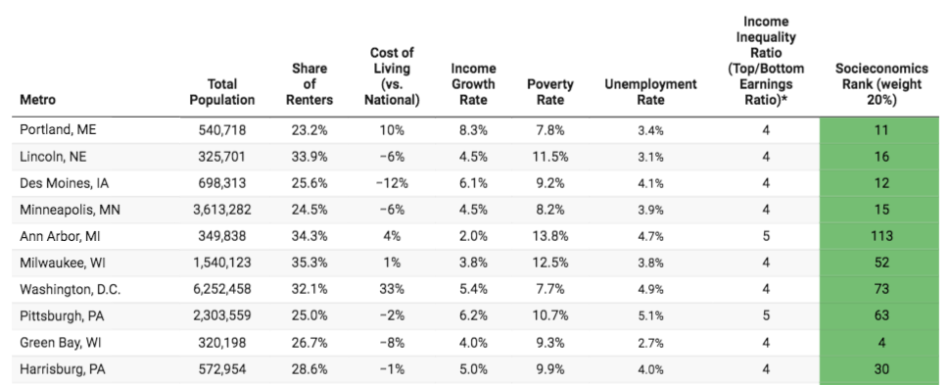When it comes to national rankings of urban areas, it’s been a tough month for Atlanta.
First came the (not) shocking assessment in November that Atlanta ranks as the country’s worst city for driving this year. Now the Big Peach’s overall livability—long a selling point for the South’s capital city—is being called into question.
For a new analysis titled, “From Coast to Coast: Which Are the Most Livable Places in the U.S. in 2024?”, national apartment search platform RentCafe studied 139 U.S. metro areas to determine the highest (and lowest) livability, based on 17 key metrics.
Livability, in this case, is defined by RentCafe as “the combination of all of the reasons that make you happy to call a place home.” This includes crucial factors such as cost of living, income inequality, poverty rates, and work commutes, as well as more localized aspects of city living such as access to gyms, entertainment, arts, and healthcare providers.
When it comes to major metros with more than 6 million people, Atlanta didn’t do so well, ranking 103rd overall, or lower than any other place not named metro Houston, according to RentCafe’s findings.
Sure, the bigger the city, the more inherent and complex its challenges, especially regarding hurdles such as cost of living, air quality, and traffic congestion. (Outside of Washington D.C., RentCafe’s Top 10 on the livability chart are all much smaller places than Atlanta.) But among its “major hubs” peers, certain aspects of Atlanta smack as disconcerting.
Resident access to exercise opportunities in metro Atlanta is the lowest among major cities (65.6 percent), and the same holds true for the number of healthcare providers (2.6 per 10,000 population). For context, Chicago, New York, and Philadelphia each count 18 healthcare providers per 10,000 residents, as RentCafe reps pointed out in an email to Urbanize Atlanta.
Metro Atlanta’s share of physically inactive residents (24.8 percent) is relatively alarming—and ditto for its share of what’s considered long commutes (51.2 percent), the worst among major cities.
But there were bright spots in RentCafe’s findings.
About 13 percent of metro Atlanta’s population—the lowest share among major cities—face severe housing issues such as overcrowding or lack of kitchen facilities or plumbing. Atlanta also boasts the highest income growth among big cities (8.8 percent) and among the lowest unemployment rate (5 percent).
 The Top 10 cities overall, beginning with the historic port city in Maine, in the 2024 livability ranking. RentCafe
The Top 10 cities overall, beginning with the historic port city in Maine, in the 2024 livability ranking. RentCafe
Despite its size and what feels like ballooning prices, Atlanta’s cost of living is still 5.2 percent below the national average, according to analysts.
“That’s 10 times lower [in Atlanta] compared to California’s metros,” note RentCafe reps. “By comparison, the cost of living in New York is 44.2 percent above the national average, and in the nation’s capital it’s 32 percent higher.”
...
Follow us on social media:
Twitter / Facebook/and now: Instagram
• Analysis: Atlanta is the worst U.S. city for driving in 2024 (Urbanize Atlanta)








